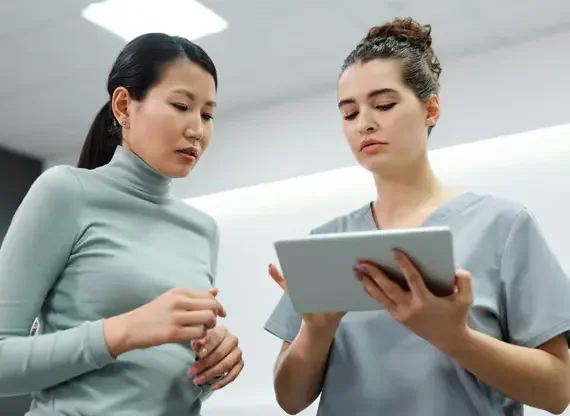
June 08, 2021
Imagine living with a disease or disorder with so many cross-over symptoms to other conditions that can lead to years of misdiagnosis. You spend years experiencing the frustration of navigating the healthcare system for an answer, only to be up-ended when you stumble upon an alternate diagnosis that also happens to affect a sizeable portion of the population.
Unfortunately, the whiplash of diagnosis merry-go-round is all too common in women’s health, making it a specialty primed for digital health tech tools. In particular, endometriosis and PCOS are two chronic conditions that women’s digital health tools can significantly support.
Endometriosis a disease in which tissue similar to the uterus lining grows in other parts of the body, is one of the most common gynecologic conditions and affects one in ten women (more than 6.5 million women alone in the US). Symptoms can include painful menstrual cramps, bowel movements, urination, and difficulty getting pregnant. Endometriosis does not typically present in imaging or blood tests. The only definitive way to diagnose it is through surgery, making it a chronic disease that takes an average of ten years for a diagnosis.
Polycystic ovarian syndrome (PCOS) is a lifelong health condition that affects approximately 6-12% of women in the US (about 5 million women). Symptoms can include irregular periods, weight gain, excess hair growth, thinning hair, and difficulty getting pregnant. Additionally, women with PCOS are at higher risk for serious health concerns, including diabetes, gestational diabetes, heart disease, high blood pressure, and stroke. PCOS may develop as early as 11-12 years of age, though many women don’t get diagnosed until they experience difficulty conceiving.
Women may spend years being treated by specialists for symptoms of these two conditions - a gastroenterologist, a dermatologist, an endocrinologist, among others - a root cause is too often elusive. Without careful tracking and observation, women may experience years of worsening disease and outcomes.
The development of women’s digital health tools and femtech apps has been steadily bubbling up on app stores over the years. From simple calendars to track menstrual periods to sophisticated fertility monitoring tools, when it comes to women’s health - there’s an app for that.
And these apps, with their ability to track and analyze user-inputted data points, can help with faster disease determination and predictive symptom management.
Connecting the dots between disparate or cross-over symptoms can lay a better foundation for better self-advocacy. Healthcare practitioners may lack experience or expertise with conditions like endometriosis or PCOS. A basis for asking for more testing or specialist referrals could mean the difference between appropriate treatment or years spent on the misdiagnosis merry-go-round.
Additionally, women’s digital health tools often offer a highly relevant, predictive approach to symptom management. For example, as users input their symptoms - ranging from options like headaches to cramps to vaginal discharge - femtech apps can calibrate and not only predict menstrual cycles but optimal ways to manage symptoms before, during, and after.
The potential power of women’s digital health tools extends beyond the benefit to the immediate subscriber. For example, a recent study published in the journal Reproductive Biology and Endocrinology used data from one popular women’s digital health app, Flo, to better understand PCOS characteristics across five countries and identify contributing risk factors in developing this disorder.
The study found bloating was the main predictor of PCOS among its respondents, with other top predictors including high blood cholesterol, glucose levels, and BMI.
Imagine being a woman navigating treatment for these symptoms, wrangling specialist visits, and often feeling at a loss for why your body feels like it has a mind of its own. Without adequate, timely diagnosis and treatment for PCOS, the challenges and frustration of living with this hormone disorder only stand to increase over time.
Gathering and analyzing population data from women’s digital health apps can facilitate more research and understanding into endometriosis, PCOS, and other gynecological diseases. In addition, through data points and connections, better avenues of patient advocacy can emerge, lobbying for improved care and consideration across healthcare organizations and government.
Additionally, the sense of community these digital health interventions can provide to patient groups in and of itself helps to remove some of the stigma and isolation from gynecological disease and disorder. Facilitating actionable recommendations and guidance for patient communities - beyond informal Facebook groups or discussion boards - can offer a higher caliber of care with credible self-serve apps and tools to demystify often complicated, interrelated diagnoses.
Although the statistics may indicate that ~6 million women in the US are diagnosed with either of these conditions, the broadly accepted reality is that these statistics are likely underreported. As a result, women’s health patients continue to fall through the cracks, but digital health innovations can put advocacy and some agency into the palms of patients.
At Bayer G4A we are working together with companies developing digital health innovations that enable access to treatment and care for everyone in order to live longer, healthier lives. This year we are especially looking for digital health companies to join us in tackling gynecological diseases such as endometriosis and PCOS and improving women’s health together. Find out more about this year’s women’s health challenges and how to apply for the G4A Partnerships Program here.